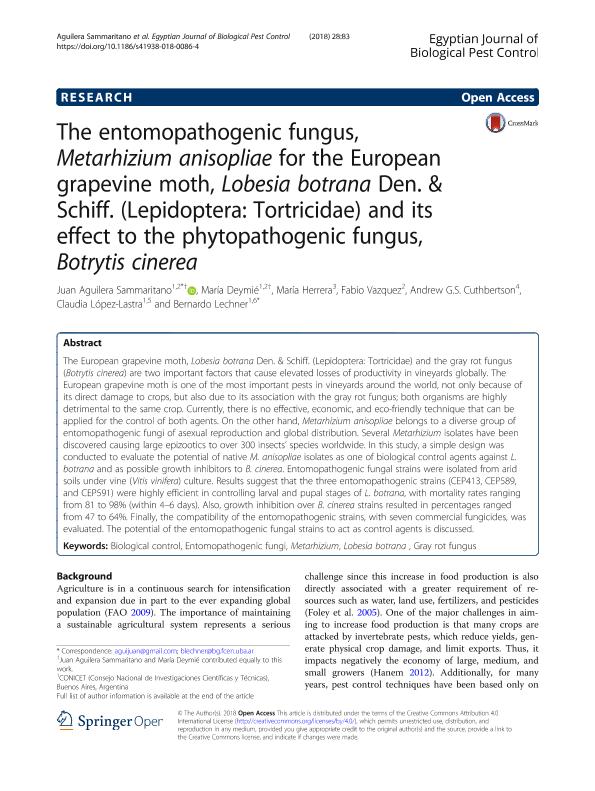Mostrar el registro sencillo del ítem
dc.contributor.author
Aguilera Sammaritano, Juan Alberto

dc.contributor.author
Deymié Terzi, María Celina

dc.contributor.author
Herrera, María
dc.contributor.author
Vazquez, Fabio

dc.contributor.author
Cuthbertson, Andrew G. S.
dc.contributor.author
Lopez Lastra, Claudia Cristina

dc.contributor.author
Lechner, Bernardo Ernesto

dc.date.available
2019-08-09T17:54:25Z
dc.date.issued
2018-10
dc.identifier.citation
Aguilera Sammaritano, Juan Alberto; Deymié Terzi, María Celina; Herrera, María; Vazquez, Fabio; Cuthbertson, Andrew G. S.; et al.; The entomopathogenic fungus, Metarhizium anisopliae for the European grapevine moth, Lobesia botrana Den. & Schiff. (Lepidoptera: Tortricidae) and its effect to the phytopathogenic fungus, Botrytis cinerea; Springer Heidelberg; Egyptian Journal Of Biological Pest Control; 28; 83; 10-2018; 1-8
dc.identifier.issn
2536-9342
dc.identifier.uri
http://hdl.handle.net/11336/81322
dc.description.abstract
The European grapevine moth, Lobesia botrana Den. & Schiff. (Lepidoptera: Tortricidae) and the gray rot fungus(Botrytis cinerea) are two important factors that cause elevated losses of productivity in vineyards globally. TheEuropean grapevine moth is one of the most important pests in vineyards around the world, not only because ofits direct damage to crops, but also due to its association with the gray rot fungus; both organisms are highlydetrimental to the same crop. Currently, there is no effective, economic, and eco-friendly technique that can beapplied for the control of both agents. On the other hand, Metarhizium anisopliae belongs to a diverse group ofentomopathogenic fungi of asexual reproduction and global distribution. Several Metarhizium isolates have beendiscovered causing large epizootics to over 300 insects? species worldwide. In this study, a simple design wasconducted to evaluate the potential of native M. anisopliae isolates as one of biological control agents against L.botrana and as possible growth inhibitors to B. cinerea. Entomopathogenic fungal strains were isolated from aridsoils under vine (Vitis vinifera) culture. Results suggest that the three entomopathogenic strains (CEP413, CEP589,and CEP591) were highly efficient in controlling larval and pupal stages of L. botrana, with mortality rates rangingfrom 81 to 98% (within 4?6 days). Also, growth inhibition over B. cinerea strains resulted in percentages rangedfrom 47 to 64%. Finally, the compatibility of the entomopathogenic strains, with seven commercial fungicides, wasevaluated. The potential of the entomopathogenic fungal strains to act as control agents is discussed.
dc.format
application/pdf
dc.language.iso
eng
dc.publisher
Springer Heidelberg

dc.rights
info:eu-repo/semantics/openAccess
dc.rights.uri
https://creativecommons.org/licenses/by-nc-sa/2.5/ar/
dc.subject
Biological Control
dc.subject
Lobesia Botrana
dc.subject
Metarhizium Anisopliae
dc.subject
Fungi
dc.subject.classification
Bioremediación, Diagnóstico Biotecnológico en Gestión Medioambiental

dc.subject.classification
Biotecnología del Medio Ambiente

dc.subject.classification
INGENIERÍAS Y TECNOLOGÍAS

dc.title
The entomopathogenic fungus, Metarhizium anisopliae for the European grapevine moth, Lobesia botrana Den. & Schiff. (Lepidoptera: Tortricidae) and its effect to the phytopathogenic fungus, Botrytis cinerea
dc.type
info:eu-repo/semantics/article
dc.type
info:ar-repo/semantics/artículo
dc.type
info:eu-repo/semantics/publishedVersion
dc.date.updated
2019-07-26T13:46:59Z
dc.journal.volume
28
dc.journal.number
83
dc.journal.pagination
1-8
dc.journal.pais
Egipto

dc.journal.ciudad
El Cairo
dc.description.fil
Fil: Aguilera Sammaritano, Juan Alberto. Universidad Nacional de San Juan; Argentina. Consejo Nacional de Investigaciones Científicas y Técnicas; Argentina
dc.description.fil
Fil: Deymié Terzi, María Celina. Universidad Nacional de San Juan. Facultad de Ciencias Exactas, Físicas y Naturales; Argentina. Consejo Nacional de Investigaciones Científicas y Técnicas; Argentina
dc.description.fil
Fil: Herrera, María. Universidad Nacional de San Juan. Facultad de Ciencias Exactas, Físicas y Naturales; Argentina. Instituto Nacional de Tecnología Agropecuaria; Argentina
dc.description.fil
Fil: Vazquez, Fabio. Universidad Nacional de San Juan; Argentina
dc.description.fil
Fil: Cuthbertson, Andrew G. S.. No especifica;
dc.description.fil
Fil: Lopez Lastra, Claudia Cristina. Consejo Nacional de Investigaciones Científicas y Técnicas. Centro Científico Tecnológico Conicet - La Plata. Centro de Estudios Parasitológicos y de Vectores. Universidad Nacional de La Plata. Facultad de Ciencias Naturales y Museo. Centro de Estudios Parasitológicos y de Vectores; Argentina
dc.description.fil
Fil: Lechner, Bernardo Ernesto. Consejo Nacional de Investigaciones Científicas y Técnicas. Oficina de Coordinación Administrativa Ciudad Universitaria. Instituto de Micología y Botánica. Universidad de Buenos Aires. Facultad de Ciencias Exactas y Naturales. Instituto de Micología y Botánica; Argentina
dc.journal.title
Egyptian Journal Of Biological Pest Control

dc.relation.alternativeid
info:eu-repo/semantics/altIdentifier/url/https://ejbpc.springeropen.com/articles/10.1186/s41938-018-0086-4
dc.relation.alternativeid
info:eu-repo/semantics/altIdentifier/doi/http://dx.doi.org/10.1186/s41938-018-0086-4
Archivos asociados
